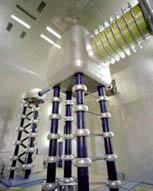Cockroft-Walton Accelerators
|
The major accelerator facilities make use of several types of devices to build up the energy of the particles. The Cockroft-Walton accelerator is used as the first stage of acceleration at Fermilab. "Inside this device, hydrogen gas is ionized to create negative ions, each consisting of two electrons and one proton. The ions are accelerated by a positive voltage and reach an energy of 750,000 electron volts (750 keV). This is about 30 times the energy of the electron beam in a television's picture tube." (Fermilab) |
 |
Developed by John D. Cockroft and Earnest T. S. Walton at the Cavendish Laboratory in England, this type of accelerator consists of a multi-step voltage divider which accelerates ions linearly through constant voltage steps. Their device had the distinction of being the first to produce an artificial nuclear disintegration by bombarding lithium with accelerated protons (published 1932).

Cockroft and Walton were able to get energies of several hundred kilo-electronvolts from the accelerator, and its upper limit is about 1 MeV. The upper limit is imposed by electical breakdown. To approach that limit, large and carefully designed insulators must be used, making this accelerator very bulky.
The high-energy limit was raised by replacing the ladder of rectified voltages with an insulating belt to transport charge in the van de Graaf accelerator.
| Types of Accelerators |
Particle concepts
Search for elementary particles
| HyperPhysics***** Quantum Physics | R Nave |